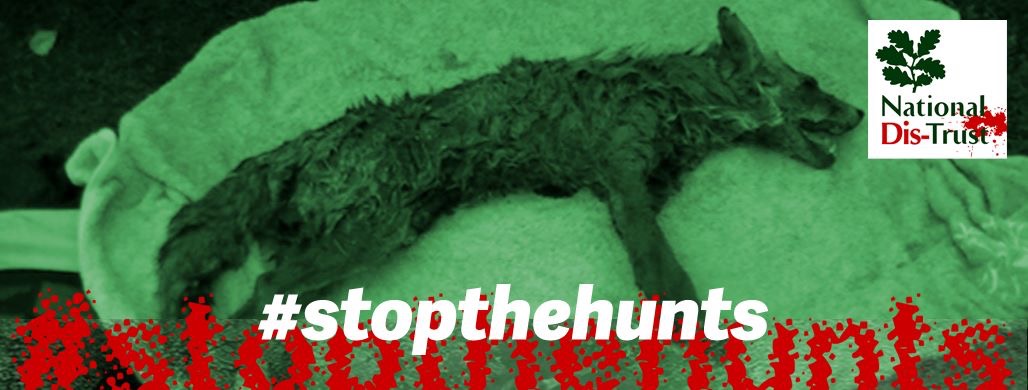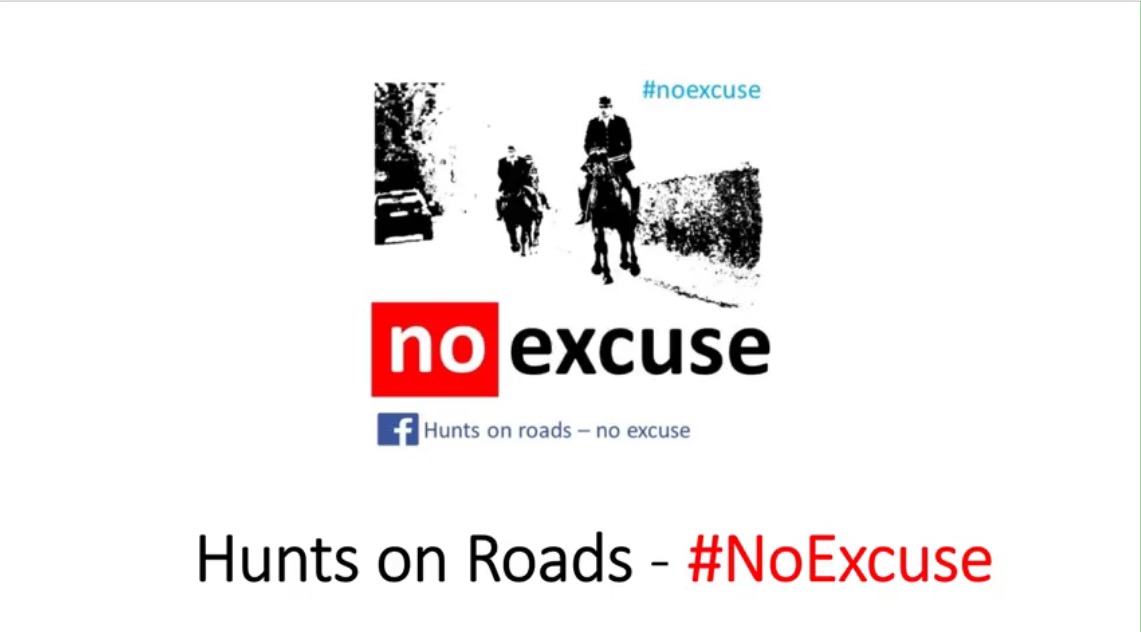1st February 2019
How To Report Hunt Incidents To The National Trust
Report illegal, thuggish, dangerous and disrespectful hunt behaviour to the National Trust in a consistent way that makes it harder for them to ignore:
-
Report illegal, thuggish, dangerous or disrespectful actions or behaviour regardless of whether it happens on National Trust land because they should take this in to account when deciding to issue a licence, or not.
-
Report hunts licenced by the National Trust.
-
Report unlicensed hunts that are trespassing on National Trust land.
General Resources
- If you need to find out which hunts are currently licensed by the National Trust, all dates & maps can be seen on our Facebook page here.
- The individual ‘photo albums’ for each hunt licence also contain the contact details for the local National Trust staff who manage the area being hunted.
- If you need to confirm if the National Trust own a particular bit of land, their property boundaries can all be seen here (NOTE: please use the ‘explore’ function to open a map).
What To Report
- Brief/concise accounts of what happened, where & when.
- Presence of terriermen.
- Blocked or damaged badger setts (if any have been discovered).
- Aggression, intimidation, abuse or violent behaviour from hunt staff or supporters.
- Any police incident numbers or crime reference numbers you have been given (always make sure to ask for these when reporting illegal hunting to the police).
- If you are able to film what’s happening please do because footage can help. If you weren’t able film or photograph then please still provide a written account of what you saw to the National Trust and don’t let them dismiss you for not having footage.
Who To Report It To
- Contact details for the most relevant point of contact within the National Trust for each hunt licence can be found here.
- In addition to this, please also CC in Nick Droy and his ‘trail hunting’ management team at [email protected] as well as ourselves at [email protected]
Finally….
- National Dis-Trust volunteers will always be on hand if you are unsure about how to go ahead with any of the above (especially hunt trespass) as relevant National Trust contact details may not be readily available.
- Contact us on Facebook, Twitter or via [email protected]
Jack Riggall, National Dis-Trust.
Please share.
2nd September 2018
Hunts On Roads - #NoExcuse
One of the most extraordinary photos Surrey Hunt Monitors has taken is of Morestead Road, near Winchester. It’s an unremarkable road, but at about 2.15pm on Saturday 27 January 2018 it looked like a canine racetrack.
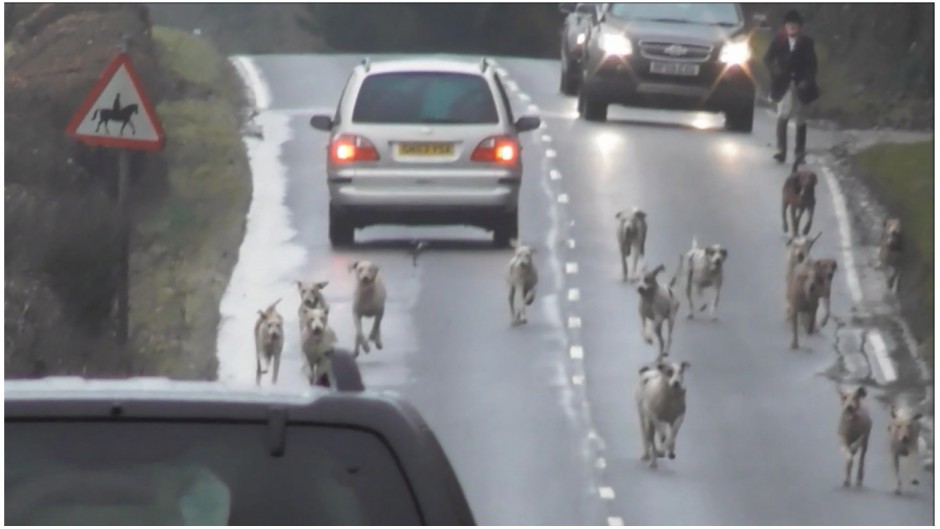
Funny old place to lay a trail. It would be almost as stupid as on the A1(M) motorway in North Yorkshire (28 January 2017), or through a cat sanctuary in Kent (9 January 2018).
Of course it wasn’t actually the case that a trail was laid in any of these places. In each case the hounds had been following animal scents. In the Morestead Road case, the scent was of two deer which had been chased by the hounds and had crossed the road a short while before.
What happened next was referred to on Twitter as #HuntHavoc. It’s a very appropriate term. It risks lives, not just of the animals being chased and the hounds doing the chasing, but also the people driving on the roads who, at any moment can find themselves in the wrong place at the wrong time, like the driver of this car who had to make an emergency stop and swerve to avoid one of the Morestead Road hounds as it emerged from the undergrowth along the side of the road and into his path:
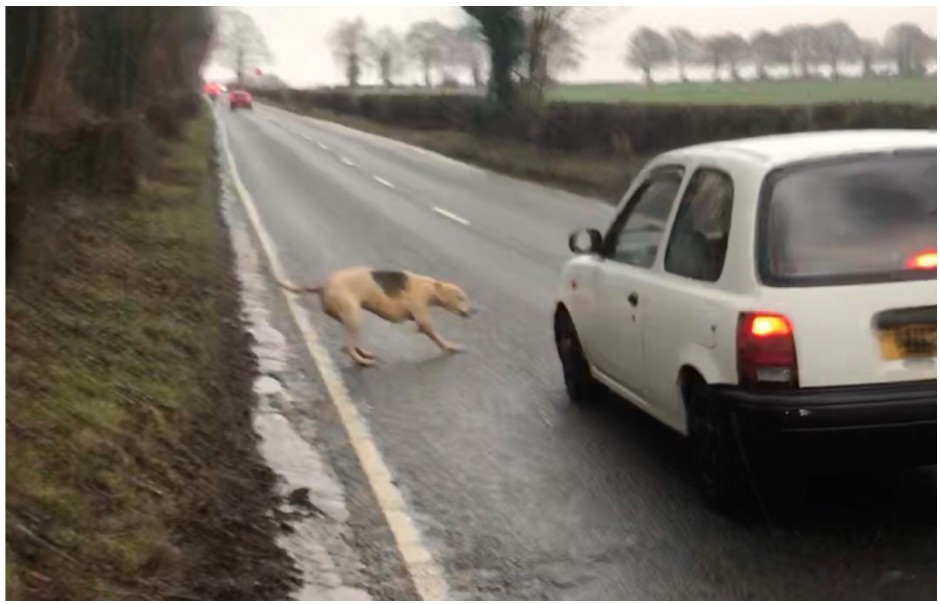
For a video of this on Twitter see here.
A driver cannot help his or her instincts. See a dog run out in front of you, and you will do as he did and swerve as well as brake. If a car had been coming the other way, a very nasty collision could well have occurred.
So whose fault would it have been? Not the driver’s, but the owner of the hound. And that’s because dogs on roads are inherently dangerous that the Road Traffic Act 1988 contains a provision - Section 27, subsection (1) - which makes it a criminal offence to cause or permit a dog to be on a road without the dog being held on a lead.
So isn’t it obvious then, that the owners of hounds which go on roads are committing an offence? Actually, no. As with all legal issues connected with hunting, its not so simple as that. The hunting lobby had powerful friends in Parliament when this Act was passed and they ensured an exception for hunts. It reads: “subsection (1) … does not apply to dogs proved … to have been at the material time in use under proper control for sporting purposes”. Hence it is perfectly legal, whilst out hunting, for a pack of well-behaved hounds to trot along a country lane with the hunt in the classic picture-postcard image hunts like to portray.
But the key words for this purpose are “under proper control”. In what possible sense is a hound under proper control if it is on a public road chasing a fox or deer? In the Morestead Road case, it was such a clear cut situation that the local (Hampshire) police investigated and interviewed the relevant hunt, the Hursley Hambledon Hunt. The matter appears to be nearly resolved with a Community Resolution Order, meaning that the hunt accepts responsibility and writes a letter of apology. Whilst not a conviction, it is a step on that road (if the pun will be forgiven) and the Hursley Hambledon Hunt will have to be much more careful in this coming season, since the next offence would likely mean a caution, and the one after that a court appearance.
The “squeeze”
However, there can be other cases where it is arguably not so clear. The hounds may not be on the road for so long, for example, with the hunt arguing the hounds were in fact under control. This is when what lawyers like to call a “squeeze” can be brought into play.
Consider a case where a hunt is accused of unlawful hunting under Section 1 of the Hunting Act 2004. The defence is invariably of “accident”: the hounds were following a trail when they just happened to come across a fox and chased it. The recent Grove and Rufford and Portman Hunt cases are just two examples. Hounds could not be called back (despite best efforts, of course). Or the huntsman was not sufficiently close to the hounds to be in control and hence responsible. But if the huntsman was not close enough to control his hounds, or was close, but not able to control them, and they cross a road, the Section 27 offence surely cannot be avoided: there is a “squeeze” between the two offences. In order to escape the Hunting Act offence, the hunt is inescapably admitting (indeed positively claiming) a lack of control and hence the commission of an offence under the Road Traffic Act.
Hound exercise
Another activity undertaken by hunts is “hound exercise”. This is in principle an unobjectionable behaviour in as far as the hounds are simply taken out for a run. If only hunting were replaced entirely by hound exercise! However, hounds need exercise every day and it must be a significant effort to put them in a van and drive them to somewhere safe to get this. Hence it’s not surprising that some hunts use roads to access nearby fields.
The question is, does the hunting exemption then apply? The clear answer is “no”. To repeat, the relevant language of the defence is (emphasis added): “subsection (1) … does not apply to dogs proved … to have been at the material time in use under proper control for sporting purposes”. The fact the hounds are used three times a week for hunting is of no relevance to the other four days of the week. There is no blanket exemption for foxhounds. When hounds are being taken out for exercise and use a road they must, like any other dog, be on a lead, or else an offence under Section 27 of the Road Traffic Act will be committed.
Some hunts are worse again and do not even bother to take the hounds to a field. One example local to Surrey Hunt Monitors is the Hampshire Hunt. They’re based in a quiet village called Ropley and here one can often see the entire pack being led around the village roads by three cyclists causing chaos:
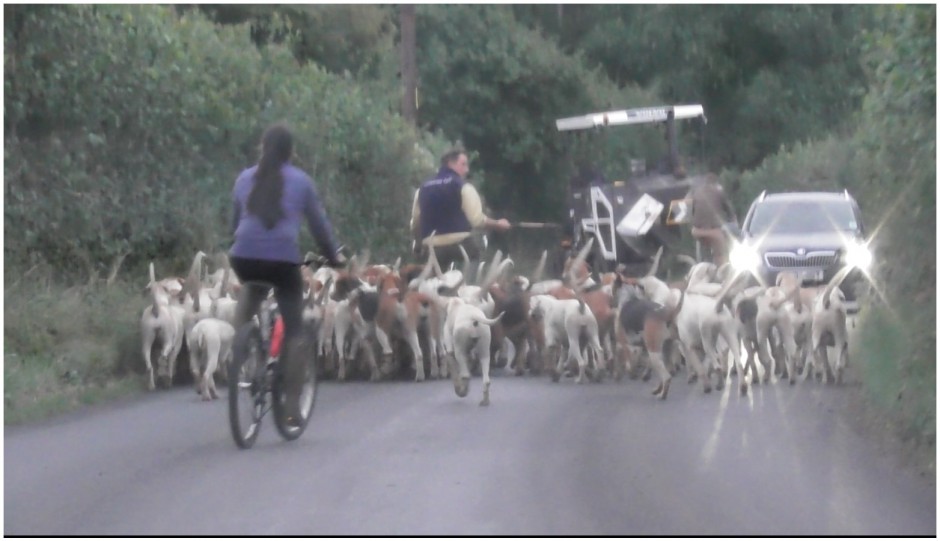
… not to mention depositing a large amount of dog mess …
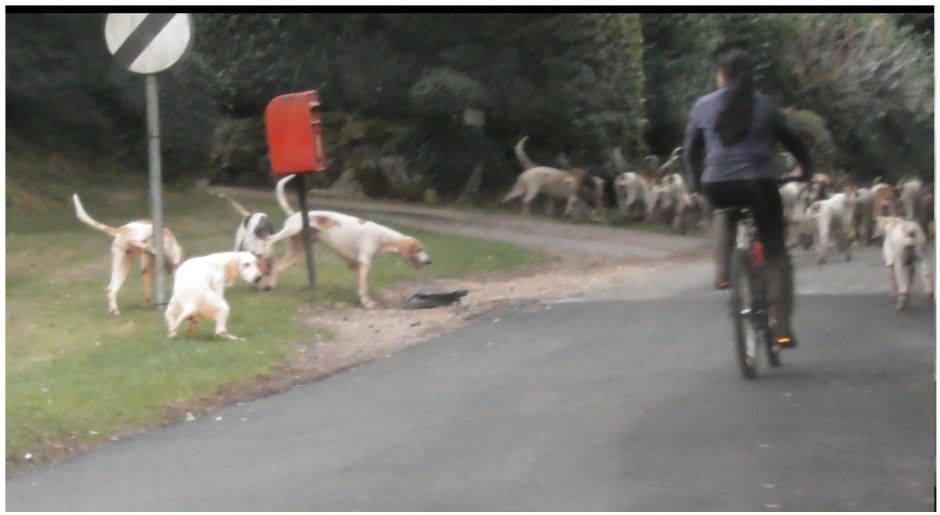
Two sample incidents have recently been reported to Hampshire police, and we await hearing from them as to if and how they intend to proceed.
Advice for Campaigners and the Public
Convictions under the Road Traffic Act are distinctly second best to Hunting Act convictions, but given the difficulty of the latter, they represent a way forward in controlling the reckless behaviour of hunts. So we offer two bits of advice;
1. If you are out early one morning hoping to catch your local hunt cubbing and only see them exercising their hounds on the local roads, dial 101 and report them under S.27 Road Traffic Act 1988. If the police say hunts are exempt, put them straight.
2. On hunt days, when hunt hounds cross a road in pursuit of a fox or deer, report both illegal hunting and the RTA offence and the chances are the hunt will walk straight into the “squeeze”. Let’s at least stop #HuntHavoc before an innocent person is killed in addition to the thousands of innocent foxes who die every year in so-called trailhunting “accidents”. After all, there is #NoExcuse.
© A Surrey Hunt Monitor

